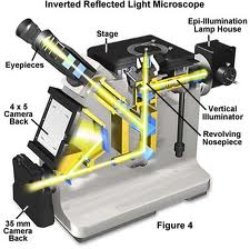Inverted Microscope
Advantages, Disadvantages and Recommendations/Buyer's Guide
The inverted microscope is designed with the light source and the "condenser" lens above the specimen.
The condenser lens concentrates the light.
The "objective" and turret of the microscope is on the bottom. The objective focuses the light to produce a real image.
Inverted vs Upright Microscope
Basically, in an upright microscope, you look down to see the image, and with an inverted model, you look up.
This type is commonly used in metallurgy, cell culture and for viewing aquatic specimens.
This microscope model is a very good choice if your sample to be viewed is in suspension or is very large and heavy.
The inverted is offered with two models - routine and research. An upright microscope can be purchased as a smaller model for student use which influences price.
History
A Dutch spectacle maker named Zaccharias Janssen invented the first microscope in about 1590.
Merely a series of lens in a tube, it was the forerunner of today’s compound microscope.
 Inverted Microscope Labelled Diagram
Inverted Microscope Labelled Diagramfrom olympusmicro.com
A light source was added by Anton van Leeuwenhoek, and the lenses improved, in the late 1600s.
However, until the 1800s there were few major improvements in the light microscope.
Then in 1850, John Lawrence Smith, a faculty member at what is now Tulane University, invented the inverted microscope.
This was a radical shift from the existing microscopes where the specimen had to be small and preserved on a slide.
For the first time, living and large specimens could be observed.
More information available here about the History of the Microscope and Its invention
Inverted Microscope Capabilities
This is an excellent microscope for metallurgical samples, and for the observation of living specimens or tissues.
Therefore, the process of cell division can be examined which is not the case using a conventional compound microscope.
What makes an inverted model useful is the ability to maintain a more natural environment for the specimen, thus, extending its life. The viewing of valuable life processes can be researched longer. This is its major advantage over a compound light microscope.

Featured right: fungal culture on a petri dish.
The large specimen/culture may be kept in a large petri dish for viewing instead of on a slide. In a larger container with an appropriate cover there would naturally be less evaporation and more gas exchange to maintain life.
This is not possible when a thin specimen is placed under a cover slip on a slide where evaporation happens too quickly.
Disadvantages
The largest disadvantage is the cost.
There are fewer manufacturers and the engineering to manufacture the microscope is more expensive.
This means there are fewer used microscopes of this type on the market, and less competitive pricing.
Additionally, all microscopes have a limited working distance for focusing on the specimen.
When using the inverted type, this difficulty is compounded by the reality of looking up through containers of various optical quality and thickness.
You may look through plastic, which has a much different optical correction than the thin glass slip on a standard slide used with a conventional microscope.
Advantages
A single drop of pond water shows a diversity of life and it’s interaction on a microscopic level. The ability to observe living specimens with this microscope has added greatly to the knowledge in molecular and cellular biology.
As stated earlier, the living specimen can also be observed over a longer period of time.
Also the inverted microscopes permit use of Kohler Illumination which is a great option as well as DIC and phase contrast optics (creating different shades of brightness) greatly enhancing the image for better viewing instead of needing to stain the specimen and thus kill it.
In the case of large or heavy specimens, such as those in metallurgical sampling, a conventional microscope is useless.
But the inverted model, due to its design is perfect for analysis.
Additionally, models typically have connection ports, which allow them to be attached to a variety of digital recording equipment.
The option of recording the interaction of a specimen in its environment allows for validation and review of the real time observations.
Manufacturers
There are several manufacturers of this type. They include:
1/ Meiji Techo offers several inverted models, depending on the intended application.
- For biological use, they offer several models starting with the Omano OM 900
- The higher end Meiji TC5500/TC5600 - Epi-Fluorescent Biological Microscope
- A metallurgical microscope, the basic Omano OMM300T - Inverted, Polarizing, Metallurgical Microscope
- The still cost-effective Meiji IM7100 - Inverted Brightfield Metallurgical Microscope
2/ UNICO offers several biological inverted microscopes in their UNICO IV950 Series of Microscopes.
- These microscopes are designed for tissue cultures, as well as cellular and microbiology.
- UNICO does not list metallurgical inverted microscopes on their website.
AmScope available on Amazon.com is a manufacturer known for their quality and offers inverted microscopes.
While the cost may be somewhat prohibitive, there is no better microscope on the market for live observations.
When purchasing, look for accessories which are readily available (like on Amazon.com) for what you want to do, and that will allow you to grow with the equipment.
MicroscopeMaster's Recommendations
Check out MicroscopeMaster's Review of the Amscope 50x-1000x Inverted Metallurgical Microscope.
There are a range of price points on the market with reliable manufacturers for these microscopes however, the Amscope and Omax range of inverted microscopes are worth checking out for quality vs price.
Return from Inverted Microscope to Compound Light Microscope
Return from Inverted Microscope to Best Microscope Home
Find out how to advertise on MicroscopeMaster!





